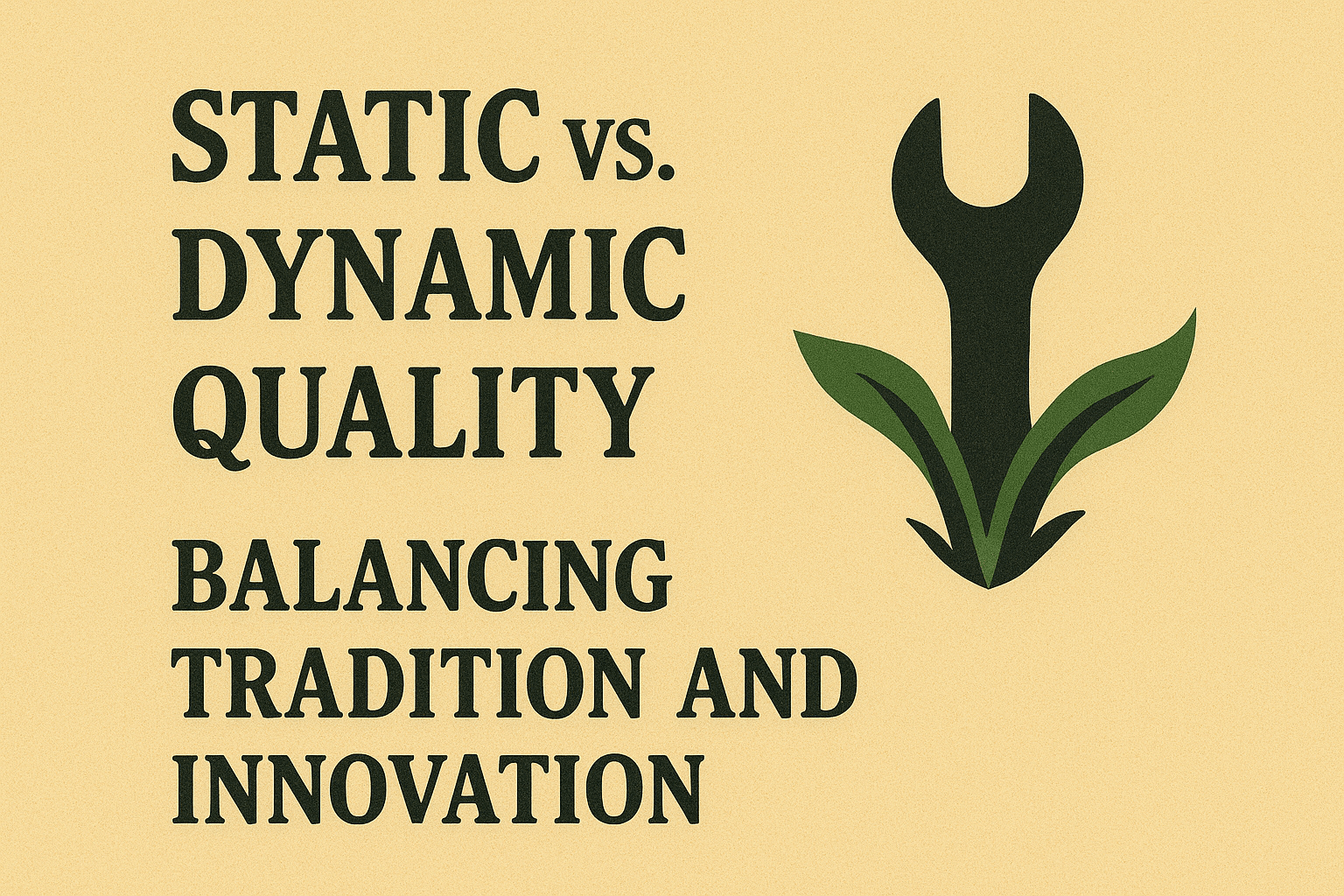An in-depth analysis of the balance between static quality (tradition, order) and dynamic quality (innovation, change) in various fields, such as technology, education, and art.
Robert M. Pirsig’s Metaphysics of Quality (MOQ) introduces a profound philosophical framework that divides quality into two interrelated aspects: static quality and dynamic quality. This division helps us understand the balance between tradition and innovation, order and change, in various fields such as technology, education, and art. By exploring this balance, we can appreciate how these forces interact and shape our world, fostering progress while preserving essential structures.
Understanding Static and Dynamic Quality
Static Quality refers to the structured, ordered, and predictable aspects of life. It encompasses traditions, norms, rules, and established patterns that provide stability and continuity. Static quality is essential for maintaining the frameworks within which society operates, offering a sense of security and reliability.
Dynamic Quality, on the other hand, represents the spontaneous, innovative, and evolving aspects of life. It is the force of creativity and change that disrupts the status quo, driving progress and transformation. Dynamic quality is seen in moments of inspiration, breakthroughs, and the exploration of new possibilities.
Pirsig’s philosophy emphasizes that both static and dynamic quality are necessary for a balanced and thriving existence. Static quality provides the foundation upon which dynamic quality can build, and dynamic quality ensures that static structures do not become stagnant or oppressive.
Balancing Tradition and Innovation in Technology
The field of technology exemplifies the interplay between static and dynamic quality. Technological advancement relies on a delicate balance between maintaining reliable systems and pushing the boundaries of what is possible.
- Static Quality in Technology: Established technologies and systems provide the backbone for innovation. For example, the internet’s infrastructure, standardized programming languages, and stable operating systems are static elements that ensure reliability and functionality.
- Dynamic Quality in Technology: Innovation in technology is driven by dynamic quality. The development of artificial intelligence, quantum computing, and renewable energy solutions exemplifies the creative and transformative force of dynamic quality. These innovations challenge existing paradigms and offer new possibilities for the future.
- Balancing Act: Successful technological advancement requires a balance between preserving essential structures and embracing innovation. Companies like Apple and Google excel by maintaining robust, reliable systems while continually pushing the envelope with new products and services. This balance ensures both stability and growth, allowing for sustainable progress.
Balancing Tradition and Innovation in Education
Education is another domain where the balance between static and dynamic quality plays a crucial role. Effective education systems must preserve foundational knowledge while adapting to new insights and methodologies.
- Static Quality in Education: Core curricula, standardized testing, and traditional teaching methods represent static quality in education. These elements ensure that essential knowledge and skills are imparted consistently across different contexts. They provide a structured framework that students and educators can rely on.
- Dynamic Quality in Education: Dynamic quality in education is reflected in the adoption of innovative teaching techniques, the integration of technology in the classroom, and the emphasis on critical thinking and creativity. Progressive educational models, such as project-based learning and personalized education plans, embody the dynamic aspect by adapting to the unique needs and interests of students.
- Balancing Act: Balancing tradition and innovation in education involves integrating new methodologies without discarding the proven effectiveness of traditional approaches. Educators who blend classical education techniques with modern technology and student-centered learning create environments that foster both academic excellence and adaptability.
Balancing Tradition and Innovation in Art
Art thrives on the tension between tradition and innovation, with static and dynamic quality playing pivotal roles in artistic expression and evolution.
- Static Quality in Art: Artistic traditions, techniques, and genres represent static quality. Classical training in drawing, painting, music, and dance provides artists with a solid foundation of skills and knowledge. These traditions preserve cultural heritage and ensure the continuity of artistic forms.
- Dynamic Quality in Art: Dynamic quality is evident in the constant evolution of art forms, styles, and mediums. Contemporary art movements, digital art, and experimental music exemplify the innovative spirit that challenges conventional boundaries and introduces new modes of expression.
- Balancing Act: Artists who achieve a balance between tradition and innovation often produce the most impactful work. By mastering traditional techniques and then pushing them in new directions, they create art that is both rooted in history and forward-looking. For instance, the fusion of classical painting techniques with digital media can result in groundbreaking works that resonate with diverse audiences.
Conclusion
The balance between static and dynamic quality, as articulated by Robert Pirsig, is essential for fostering a harmonious and progressive society. In technology, education, and art, this balance allows for the preservation of valuable traditions while embracing the transformative power of innovation. By understanding and applying this balance, we can navigate the complexities of modern life, ensuring stability and growth, order and creativity. Ultimately, the interplay between static and dynamic quality enriches our experiences, drives progress, and helps us build a more resilient and dynamic world.
